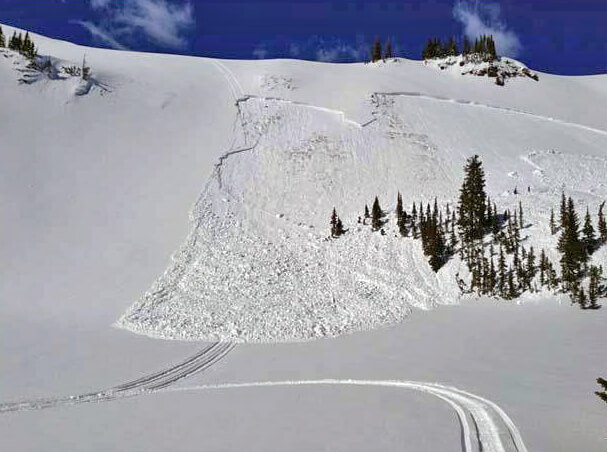Backcountry Classroom: Avalanche Safety
by Robina Moyer
Broadcast 2.2016, 2.2019, 2.1 & 2.4.2022

Slab avalanche, photo by USDA (CC 2.0).
Listen:
Over the past several years I’ve been introduced to the freedom offered by ducking resort boundary lines and skiing in the backcountry. But the more I’ve grown to love skiing the backcountry, the more I’ve come to respect the immense and unpredictable power of snow.
I armed myself with the necessary gear—a beacon, shovel, and probe—but in reality relied heavily on my friends’ knowledge to keep me out of danger. Finally deciding that my safety is ultimately my own responsibility, I enrolled in a Level 1 Avalanche class and soon found myself winded and sweating after skinning to the top of a windy peak just outside the boundary rope of my local ski hill. The vantage provided phenomenal views and the ideal classroom. After two days of snow, graupel, and rain, the valley was the perfect storm of conditions to observe the avalanche factors we had discussed in the classroom.
In order for an avalanche to occur there needs to be a bed surface for it slide on, a slab of additional snow on top of the bed, and a trigger to release the slide. Most avalanches release on slopes between 30° and 45° and are caused by a weak layer in the snow between the bed surface and the slab, which releases and slides. A weak layer may be due to an accumulation of new snow that has not yet settled into the existing base, or may be persistently weak, caused by conditions earlier in the season. Persistent weak layers can be the result of graupel, frozen snow pellets which act like ball bearings between layers; buried surface hoar, formed when surface snow crystals become faceted during cold snaps and are later buried; or from a buried crust formed from a freeze-thaw cycle or a winter rain storm. A weak layer prevents new snow from binding to the bed layer and can increase the chance of a slide.
New precipitation, particularly rain or heavy, wet snow, can significantly increase the likelihood of an avalanche. Fresh heavy snow can compress the existing base and tax its stability, and the additional weight of a skier may be enough to trigger a slide. Rain can seep through the snowpack and begin eroding the base layers from the bottom up, also decreasing stability. Storms that dump fresh snow often come with strong winds, especially in the rugged mountain ranges of western Montana. Wind is efficient at moving snow quickly and a steady breeze can rapidly create wind lips and snow drifts. These conditions mean that one aspect of a peak or hillside may have significant wind loading after a storm event, creating deeper snow and a higher avalanche risk.
As spring approaches, wet slides become more frequent, triggered by warmer temperatures, increased sunshine, and thawing snow. For this reason, a south-facing aspect on a sunny day is probably not the best place to venture on a springtime afternoon.
If you are out in the backcountry there are several warning signs that you should take seriously. Small slides or sloughs on nearby slopes, fresh debris piles, audible “whompfing” noises, or visible cracks in the snow are all signs that you should exercise caution when deciding where to travel. While these factors only brush the surface of avalanche forecasting, they are important to keep in mind if you’re planning to head out to the mountains in the winter.
The thought of being buried is terrifying, and I hope to never encounter an avalanche firsthand. Yet, it’s not terrifying enough to stop me from earning my turns and rejoicing in the feel of skiing down fresh, untouched powder.
Every week since 1991, Field Notes has inquired about Montana’s natural history. Field Notes are written by naturalists, students, and listeners about the puzzle-tree bark, eagle talons, woolly aphids, and giant puffballs of Western, Central and Southwestern Montana and aired weekly on Montana Public Radio.
Click here to read and listen to more Field Notes. Field Notes is available as a podcast! Subscribe on Apple Podcasts or wherever you listen to podcasts.
Interested in writing a Field Note? Contact Allison De Jong, Field Notes editor, at adejong [at] montananaturalist [dot] org or 406.327.0405.
Want to learn more about our programs as well as fun natural history facts and seasonal phenology? Sign up for our e-newsletter! You can also become a member and get discounts on our programs as well as free reciprocal admission to 300+ science centers in North America!












